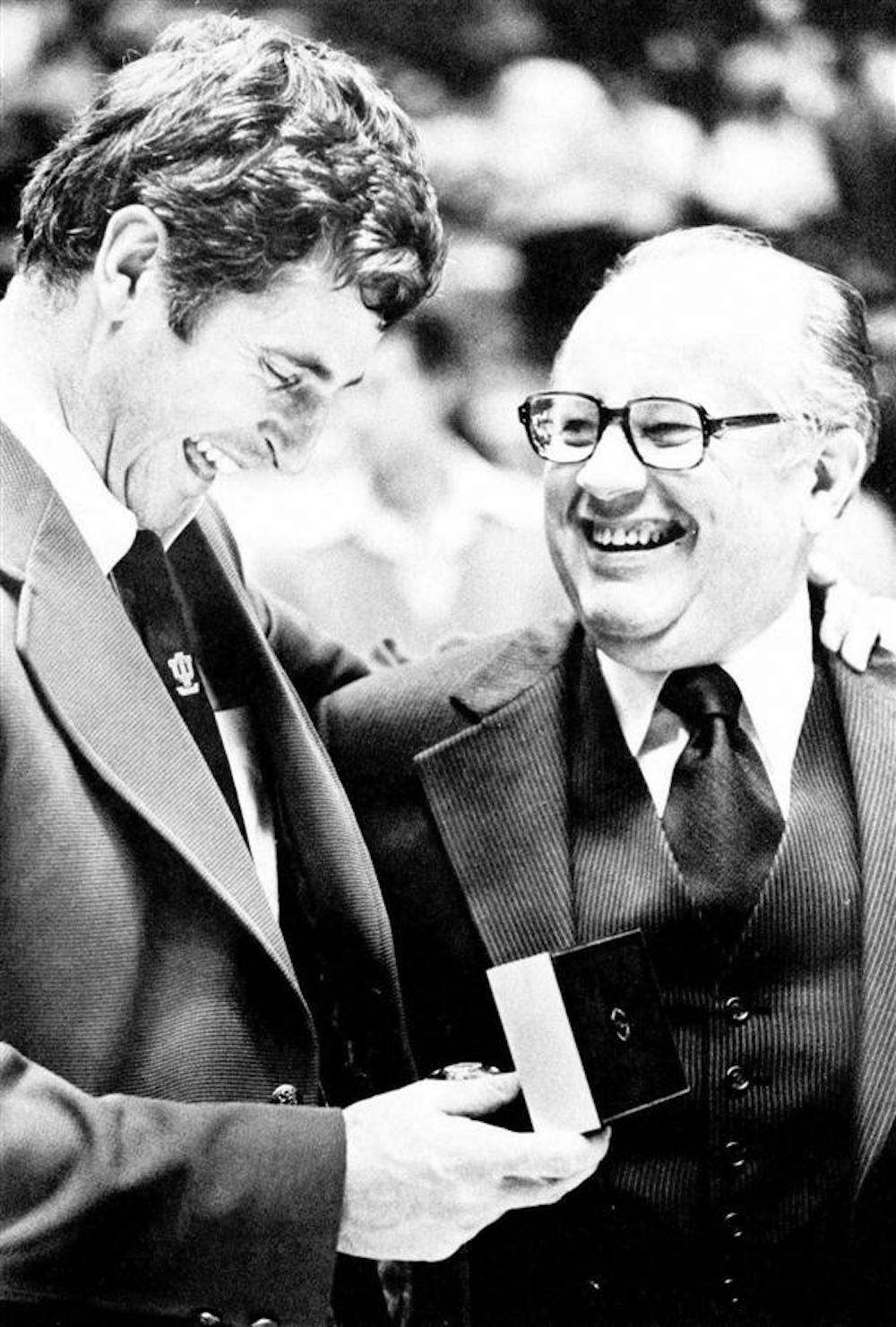When John Ryan announced his retirement from the position of IU president in 1986, the news didn’t make many waves with the student body. Even the staff of IU’s yearbook, the Arbutus, buried the announcement in a roundup of other random news items from that spring.
But by the time 81-year-old Ryan died early Saturday at IU Health Bloomington Hospital, his list of admirers was long. His list of accomplishments at IU may have been even longer.
During his 16 years as president, Ryan oversaw the creation of regional campuses in Richmond, Ind., and New Albany, Ind. He also established the IU Office of International Affairs, as well as the School of Public and Environmental Affairs.
And, in 1978, he allowed the filming of the Oscar-winning movie “Breaking Away” to take place on campus, immortalizing Bloomington, IU and the Little 500 in a way only Hollywood could do.
“For more than half a century, John Ryan played a pivotal role in the growth and development of IU and was a major figure in higher education nationally and internationally,” IU President Michael McRobbie said in a statement Saturday. “He had a remarkable vision for how the University should evolve, both across the state and around the world.”
* * *
John. W. Ryan, sometimes called Jack, was born just one state over in Chicago in 1929, but he did not walk a straight path to the office of IU president. He travelled west after high school to earn his bachelor’s degree at the University of Utah.
He first came to IU in the late 1950s, earning a master of arts and a Ph.D. in government in 1958 and 1959, respectively. He did not return to IU until 1968 when he became vice president of IU’s regional campuses. Three years later, he was named the new IU president.
“He was a strong leader who took the helm as president at a difficult time and earned the respect of the faculty, staff, state legislature and alumni,” McRobbie said.
* * *
The difficulties Ryan faced as president were not simply ones of administrative bureaucracy.
In 1978, a blizzard dumped 29 inches of snow on campus, 14 of which fell in a two-day period that also saw subzero temperatures — a crisis made even worse by a 110-day coal miners’ strike. Ryan and other University officials had been anticipating the strike, stockpiling 38,000 tons of coal. This usually would have been enough to see the University through a normal winter.
But, with the unexpected extreme conditions, the University found itself burning nearly 500 tons of coal a day.
In an effort to conserve energy, elevators and escalators were shut off, as were electric hand dryers, ventilation fans and coolers, which refrigerated campus water
fountains.
The heating in some campus buildings was forced to stay in the low 60s and lights in many classrooms with windows remained off.
Things continued to get worse. With talks between mine owners and striking workers falling apart, the University needed to reduce its energy use by an impossible
50 percent.
Ryan approved an order for an emergency recess, and IU was closed for three weeks in March until a deal was finally made after spring break.
More trouble was ahead for Ryan in the coming months. After facing a vote of no confidence in 1977 from the Bloomington faculty council, Ryan found himself the captain of what, by appearances, was a sinking ship.
In the past decade, salaries of IU professors had dropped from near the top of the Big Ten to the bottom. Enrollment had begun leveling off in the mid-1970s. And in 1978,
enrollment actually dropped.
“We have to see a period of no growth and perhaps even the prospects of growing smaller,” Ryan said in a State of the University address that year. “We must face the prospect of declining enrollments and raging inflation.”
He outlined a 10-year plan for the next decade and attempted to create what he called “a renaissance of spirit” at the University.
Only two years later, in 1980, Ryan was able to announce the University had received $77.7 million in gifts and grants — a 20 percent jump from previous years — and an increase in enrollment.
***
When Ryan officially retired as president in 1987, he left behind a long list of accomplishments, as well as mixed emotions among the student body.
“Although enmeshed in a virtual long-running feud with a select portion of IU students and staff — ‘He’s totally unreachable’ was the common complaint — Ryan did much during his tenure to establish IU as a national educational powerhouse,” Arbutus writer Todd Anderson wrote in 1987.
During his presidency, Ryan further established IU as one of the most beautiful campuses in the nation with the addition of the Arboretum. He charted growth for both the business school, as well as IU’s presence across the state, through its regional campuses.
He oversaw the creation of several cultural centers on campus. The University’s endowment increased from $11 million to $38 million during his presidency. He also kick-started an athletics heyday, hiring legendary men’s
basketball coach Bob Knight.
“Dr. Ryan saw the possibilities for IU as a great state university operating on an international stage at a time when few others were thinking in such terms,” McRobbie said.
Yet, at the time, some students remained unimpressed by Ryan’s quiet method of leadership. When a student-sponsored goodbye party was being planned for the president, the IU Student Association refused to contribute any money to the event.
“As John W. Ryan leaves the position of president of IU, many are filled with mixed emotions for a man that everyone and no one really knew,” Anderson concluded.
***
But as news spread of Ryan’s death Saturday, there was no shortage of people who remembered him fondly.
On a website created in Ryan’s memory, IU Chancellor Emeritus Ken Gros Louis said the former president was a strong-willed leader but was also compassionate and willing to change his mind if convinced.
“John had a terrific sense of humor, warmth and charm,” Louis said. “He made IU a better place and, like Herman Wells, was a world traveler, to IU’s benefit.”
Robert King, former chancellor of State University of New York, remembered Ryan as a man whose influence was far reaching.
King said Ryan was not someone whose ideas were limited to IU and SUNY. He served as chancellor at SUNY from 1996 to 1999.
“Jack Ryan was a rarity among men: a dreamer who created the architecture to make those dreams a reality for thousands of students across the country and around the world,” King said.
Even in retirement, and as his professional obligations drifted elsewhere, Ryan remained a friend and champion of the University.
Ryan helped to raise hundreds of millions of dollars for IU and chimed in on important decisions about its future.
“John Ryan’s love and leadership of IU never ended,” Gov. Mitch Daniels said Saturday in a press release. “He was engaged and consulted on key decisions right to the end of his days.”
***
In 2009, Ryan was presented with the University Medal, the highest honor IU can bestow. Recalling that honor, McRobbie was reminded of a gift Ryan once presented to him.
Just a few days after being named president, McRobbie said, he received a vase of red roses from Ryan.
Ryan had received a vase of similar flowers from Herman B Wells more than 30 years earlier when he was named president.
“Indiana University has lost a visionary leader and great friend with the passing of Dr. John Ryan,” McRobbie said. “He will be deeply missed.”
Ryan is survived by his wife, Patricia, two of his children and four grandchildren. His son Kerrick Charles Casey Ryan died in 2010.
Remembering the legacy of former IU President John Ryan

Get stories like this in your inbox
Subscribe





